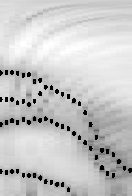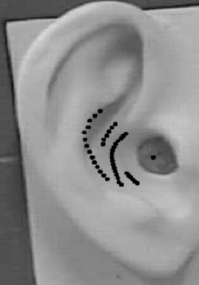[HOME] [EDUCATION] [PUBLICATIONS] [RESEARCH] [SOFTWARE] [INTERNSHIPS] [PROJECTS]
EXTRACTING THE PINNA SPECTRAL NOTCHES IN THE HRTF
Extracting the frequencies of the pinna spectral notches in measured
head related impulse responses Vikas C. Raykar, Ramani
Duraiswami, and B. Yegnanarayana, The Journal of the Acoustical Society
of America, Volume 118, Issue 1, pp. 364-374, July 2005.
![]() [A more detailed version available as
CS-TR-4609]
[A more detailed version available as
CS-TR-4609]

 The Head Related Impulse
Response (HRIR) characterizes the auditory cues created by scattering
of sound off a person’s
anatomy. The experimentally measured HRIR depends on several factors
such as reflections from body parts (torso, shoulder, and knees), head
diffraction, and reflection/diffraction effects due to the pinna.
Structural models seek to establish direct relationships between the
features in the HRIR and the anatomy. While there is evidence that
particular features in the HRIR can be explained by anthropometry, the
creation of such models from experimental data is hampered by the fact
that the extraction of the features in the HRIR is not automatic. One of the prominent features
observed in the HRIR, and one that has been shown to be important for
elevation perception, are the deep spectral notches attributed to
the pinna. We proposed a method to robustly extract the
frequencies of the pinna spectral notches from the measured HRIR. The
techniques are applied to the publicly available CIPIC HRIR database.
The extracted notch frequencies are related to the physical dimensions
and shape of the pinna.
The Head Related Impulse
Response (HRIR) characterizes the auditory cues created by scattering
of sound off a person’s
anatomy. The experimentally measured HRIR depends on several factors
such as reflections from body parts (torso, shoulder, and knees), head
diffraction, and reflection/diffraction effects due to the pinna.
Structural models seek to establish direct relationships between the
features in the HRIR and the anatomy. While there is evidence that
particular features in the HRIR can be explained by anthropometry, the
creation of such models from experimental data is hampered by the fact
that the extraction of the features in the HRIR is not automatic. One of the prominent features
observed in the HRIR, and one that has been shown to be important for
elevation perception, are the deep spectral notches attributed to
the pinna. We proposed a method to robustly extract the
frequencies of the pinna spectral notches from the measured HRIR. The
techniques are applied to the publicly available CIPIC HRIR database.
The extracted notch frequencies are related to the physical dimensions
and shape of the pinna.
Our goal is to provide researchers studying HRTFs with a tool. With this in mind we have also made available the MATLAB code for extracting the pinna spectral notches. We hope that this would enable them to study the significance of the pinna spectral notches to location perception and also to build structural models for the pinna.
[ Matlab code ] [ readme.txt ] [ Some Results ] [ CIPIC database ] [ Bibliography ] [ Future ]
Other publications related to spatial audio
The manifolds of spatial hearing Ramani Duraiswami and
Vikas C. Raykar, In Proceedings of International Conference on
Acoustics, Speech and Signal Processing (ICASSP
2005), Philadelphia, March 2005, vol. III, pp. 285-288
![]() [
Slides ]
[
Slides ]
Extracting significant features from
the HRTF
Vikas C. Raykar, B.Yegnanarayana, R. Duraiswami, and L. Davis, In
9th International Conference on Auditory Display (ICAD 2003), Boston, July 2003, pp.
115-118.
![]()
Virtual audio system customization using visual matching of ear
parameters
D. Zotkin, R. Duraiswami, L.
Davis, A. Mohan, and V. Raykar, In Proceedings of the
16th Internationl Conference on Pattern Recognition (ICPR
2002), Quebec City, August 2002, Volume 3, pp.
1003-1006
![]()
Head Related Impulse Response
Interpolation for Dynamic
Spatialization T.V.Sreenivas, Vikas C. Raykar and
Ramesh Raman, Texas Instruments DSPS fest-2k, November
2000, Banglore, India.
![]()
Extracting the frequencies of the pinna spectral notches in measured head related impulse responses. Vikas C. Raykar, Ramani Duraiswami, and B. Yegnanarayana (presented at the 148th meeting of Acoustical Society of America, San Diego, California, November 2004) [Slides]
A study of pinna anthropometry and the spectral notch frequencies. Vikas C. Raykar, Ramani Duraiswami, and B. Yegnanarayana (presented at the 148th meeting of Acoustical Society of America, San Diego, California, November 2004) [Slides]
Extracting frequencies of the pinna
spectral notches in measured head related impulse responses Vikas
C. Raykar, Ramani Duraiswami, and B. Yegnanarayana, University of
Maryland CollegePark, Department of Computer Science Technical
Report, CS-TR-4609, July 2004 (also published as
UMIACS-TR-2004-51).
![]()